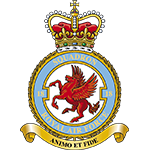RAF No 208 Squadron
Motto: Vigilant
Originally formed as No 8 Squadron RNAS on 25 October 1916 from flights of Nos 1, 4 and 5 Wings RNAS at St Pol, which had been sent to France to assist the RFC on the Western Front. Initially equipped with 1½ Strutters it re-equipped with Pups in November. In March 1917 it began to receive Sopwith Triplanes, but these were short lived as in August these were replaced by Camels. Towards the end of the year , the squadron was flying ground attack missions as well as air defence patrols. In March 1918, the squadron returned to the UK but following the German offensive of the 21th was rushed back to the Front. During this offensive, the RAF was formed on 1 April, at which point the squadron was renumber 208. It squadron continued to support the Allied offensive and advance once the German offensive had lost momentum until the end of the war, after which it joined the Army of Occupation until August 1919, when it returned to Netheravon, where it disbanded on 7 September.
The squadron reformed as a general purpose unit at Ismailia in Egypt on 1 February 1920, when No 113 Squadron was renumbered. Initially equipped with RE8s, these were soon replaced by Bristol F2Bs. In September 1922, the squadron was part of the force sent to Turkey as a result of the Chanak crisis, returning to Egypt in September 1923. The squadron then settled down to the routine of Army Co-operation duties in Egypt, re-equipping with the Atlas in May 1930, and Audaxes in August 1935. In September 1935 a 'D' Flight was formed with Demon fighters but in March 1936, these formed the basis of No 64 Squadron.
The squadron received Lysanders in January 1939 and was still equipped with these when the Italians declared war in June 1940. Operations began immediately but its aircraft were found to be vulnerable to enemy aircraft and needed a fighter escort. In November one flight was equipped with Hurricanes and these where able to undertake tactical reconnaissance and ground attack sorties but were also able to defend themselves when required. The squadron continued to provide support to the Army's advances in early 1941, but in February returned to Egypt to recover. In April the squadron was sent to reinforce British forces in Greece, but the squadron was decimated by the German fighters and with most of its aircraft destroyed, it was evacuated first to Crete and then back to Egypt.
In June 1941, the squadron was sent to Palestine, to re-equip, after which it took part in operations in Syria and provided a detachment in Iraq, until returning to the Western Desert in October. Retiring to Egypt in March 1942 the squadron rested and re-equipped with Tomahawks and Hurricanes, finally losing its Lysanders. Operations in the Western Desert were resumed in May but in November the squadron was withdrawn and sent to Iraq, where it concentrated on training and converted to Spitfires in December 1943.
In March 1944 the squadron rejoined the fighting in Italy carrying out tactical reconnaissance sorties and artillery spotting for the Allied advance towards Rome. These roles were continued through 1944 and into 1945 and when the war ended , the squadron returned to Palestine. Here it was immediately back in action in assisting in the quelling of the Jewish riots. With the formation of Israel, 208 left the country and re-located to Cyprus, whilst maintaining a detachment at Ramat David, from where it continued to carry out reconnaissance missions over its old home.
In November 1948 the squadron moved to Egypt and actually lost four aircraft to Israeli Spitfires during the war between Israel and Egypt. In January 1951, Meteor FR Mk 9s began to replace the Spitfire FR Mk 18s and by March this process was complete. When British force withdrew from Egypt, the squadron moved to Malta and also operated a detachment in Aden, however, it did not participate in the Suez operation of October 1956 as it was being run down prior to disbandment. However, formal disbandment did not occur as a new air echelon for the squadron was working up at Tangmere from a nucleus of 34 Squadron . Now equipped with Hunters the air echelon arrive din Cyprus in March and remained there until disbanding on 31 March 1959.
The squadron reformed when No 142 Squadron at Eastleigh in Kenya the following day. It was now equipped with Venoms in the fighter-bomber role, which were replaced in March 1961 with Hunter FGA Mk 9s. A move to Aden came in December 1961 with yet another move to Bahrain in June 1964. The squadron disbanded there on 10 September 1971.
The squadron reformed at Honington on 1 July 1974 as a Buccaneer strike unit, moving to Lossiemouth in July 1983. With the withdrawal of Buccaneers from service the squadron disbanded on 31 March 1994, but the next day No 234 (Reserve) Squadron at No 4 Flying training School, Valley was renumbered No 208 (Reserve) Squadron and currently operates in the advanced/weapons training role.
Standards Battle Honours*
Award of Standard originally announced on 7 Sep 1943, effective 1 Apr 1943 but presented:-
1st - 18 November 1955AVM Sir Geoffrey Bromet.
2nd - 1 June 1984
Sir Humphrey Edwardes-Jones.
Western Front, 1916-1918: Arras: Ypres, 1917: Lys: Somme, 1918: Egypt & Libya, 1940-1942: Greece, 1941: Iraq, 1941: Syria, 1941: El Alamein: Italy, 1944-1945: Gustav Line: Gothic Line: Gulf, 1991:
Squadron Codes used: GA: Apr 1939 - Sep 1939; RG: Mar 1944 - 1949;
S: Carried on Buccaneers; C: Carried on Hunters; DA - DZ: Carried on HawksWeb References:
- History of RAF Organisation: Web Reference: http://www.rafweb.org/Sqn206-210.htm
- Wikipedia, the free encyclopedia: http://en.wikipedia.org/

 Editor for Asisbiz: Matthew Laird Acred
Editor for Asisbiz: Matthew Laird Acred
If you love our website please subscribe to our YouTube video channel
Please donate so we can make this site even better !!

